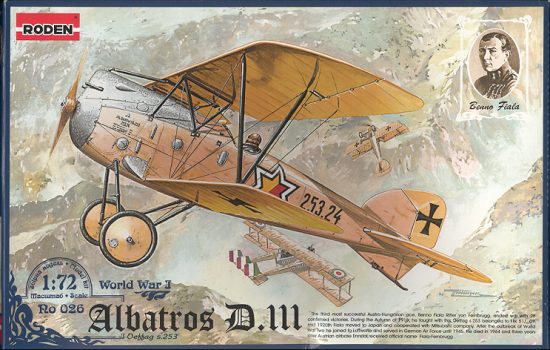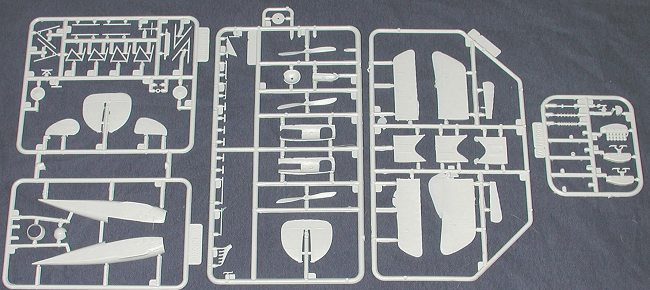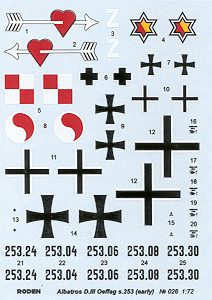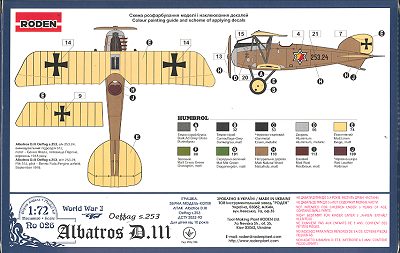
|
KIT: |
Roden 1/72 Oeffag Albatross D.III s.253 |
|
KIT # |
0026 |
|
PRICE: |
$8.98 ($7.96 at Squadron) |
|
DECALS: |
5 aircraft |
|
REVIEWER: |
|
|
NOTES: |

|
HISTORY |
As with many aircraft over time, successful (and sometimes those that don't quite meet that appellation) aircraft are often built under license. It is the same with a lot of things from cars to Coca-Cola. The Albatros D.III was a rather successful aircraft and so it wasn't unusual that it would be built by one of Germany's partners in WWI, the Austro-Hungarian Empire.
Built in Austria by the Oeffag company, the series 253 was the final version of the D.III and included all of the modifications that were made to the late s.153. As with the other Albatros fighters, it was much loved by its pilots for its speed and firepower. The final batch of series 253 aircraft had scalloped trailing edges to the ailerons and elevators. Post war, several were sold to Poland and other countries before the Armistice agreements forbade aircraft production and the plants were closed. After Germany occupied the country prior to WWII, the Oeffag plant at Wiener-Neustadt reopened and produced Bf-109s until bombed to destruction in 1944/45.
|
THE KIT |

 Roden has an excellent reputation for producing quality WWI kits. This one
follows some of those. Molded (or at least boxed) in Ukraine, the quality of the
moldings is really very good. There are no problems with ejector pin marks;
careful inspection finding them only on the inside of large parts like the
fuselage halves. There were no sink marks, but some kits have quite a
bit of flash on some of the parts as you can see on the large right-hand sprue.
Other parts had some rough edges, but nothing major. The sprues of all of the
Roden Albatros D.III kits are identical and have the bits and pieces needed to
build any of the various series aircraft. The instructions will tell you
which parts are needed to build which aircraft.
Roden has an excellent reputation for producing quality WWI kits. This one
follows some of those. Molded (or at least boxed) in Ukraine, the quality of the
moldings is really very good. There are no problems with ejector pin marks;
careful inspection finding them only on the inside of large parts like the
fuselage halves. There were no sink marks, but some kits have quite a
bit of flash on some of the parts as you can see on the large right-hand sprue.
Other parts had some rough edges, but nothing major. The sprues of all of the
Roden Albatros D.III kits are identical and have the bits and pieces needed to
build any of the various series aircraft. The instructions will tell you
which parts are needed to build which aircraft.
The instructions are superb. There are several easy to follow construction steps
that annotate colors and which options are used with which decal selection. It
seems that colors are all in the Humbrol range, which is most widely used in
Europe so a natural to use. The decal sheet is quite colorful and covers all
five aircraft, including the box art aircraft of Austro-Hungarian Ace Benno
Fiala Ritter von Fernbrugg, the third highest ranking in the Austrian air
service with 28 confirmed victories. The back of the box has a full color two
view of his aircraft as well as a color chart for all the colors used in making
the kit. A very nice touch that I hope will catch on. The
rest of the schemes cover other Austrian pilots and some of the camouflage
schemes are going to be a real challenge to reproduce as they were printed
directly on the fabric rather than painted on. A good reference would be
'Air Aces of the Austro-Hungarian Empire; 1914-1918'. I imagine that the
researchers used this tome to gather markings info.
The
rest of the schemes cover other Austrian pilots and some of the camouflage
schemes are going to be a real challenge to reproduce as they were printed
directly on the fabric rather than painted on. A good reference would be
'Air Aces of the Austro-Hungarian Empire; 1914-1918'. I imagine that the
researchers used this tome to gather markings info.
|
CONCLUSIONS |
In all respects, this looks like a very nice kit. The minor problem with flash can easily be taken care of and is not endemic to the mold. Another Albatros kit I have was devoid of the large areas of flash seen in the image above. Because of the small and delicate parts, I wouldn't recommend this to a beginner, but if WWI aircraft are your forte, then this one should be on your want list!
You can find this kit and many others at

If you would like your product reviewed fairly and fairly quickly by a site that has well over 150,000 visitors a month, please contact me or see other details in the Note to Contributors.
Back to the Previews Index Page